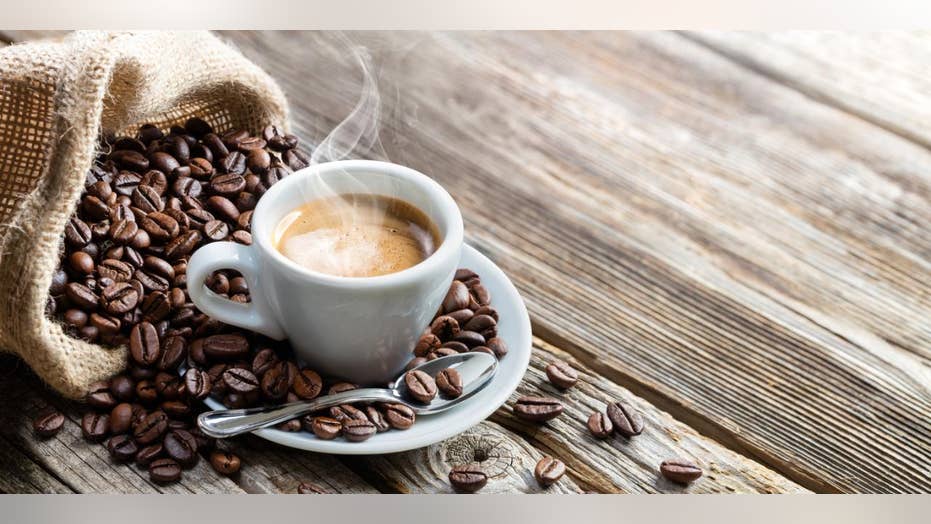All about Espresso

The espresso drink as we know it today, dates back to 1947, when Gaggia introduced the original device capable of producing constant high pressure during the shot pulling. The equipment was called Gaggia Crema Caffe and was meant for business usage. Prior To the Gaggia Crema Caffe practically every commercial and customer espresso machine was steam driven, similar to the modern moka pot brewer.
Full story here - Click for more info
Espresso is a delicious, strong coffee beverage. The common offering, a shot, is made by forcing pressurized hot water through finely ground coffee beans.
Espresso has a thicker consistency than coffee prepared by various other brewing techniques. It has a greater concentration of suspended and dissolved solids and crema.
Espresso has all of the same flavors of coffee but magnified-- bitter, lightly sweet, acidic, toasty. The exact flavor profile will differ depending on the coffee roast. It has a thicker, creamier appearance than regular coffee.
Espresso isn't a different coffee bean, although roasting houses may have a special procedure for beans predestined to become espresso. As a matter of fact, roasters may like to use high-grade robusta beans to add an extra kick of caffeine.
Espresso or Expresso-- Use the Right Name
The spelling expresso is usually considered incorrect, though some sources call it a less frequent version. Italy works with the term espresso, replacing s for the majority of x letters in Latin-root words; x is not considered part of the standard Italian alphabet. Italian individuals commonly describe it just as caffè (coffee), espresso being the normal coffee to order; in Spain, while café expreso is viewed as the a lot more "formal" denomination, coffee shop solo (alone, without milk) is the normal means to ask for it when at an espresso bar.
Espresso Extraction
Espresso is prepared by pushing hot water through a layer of compacted ground coffee, contained in a port-filter. Espresso is an extremely concentrated coffee, with a great deal of aroma, body, and flavor. It has a lot of coffee oils and solids. One of the most distinctive features of espresso are the sudsy layer on top and the reduced volume of the drink. Pulling a shot of espresso needs training and understanding, have a look at our espresso brewing guide, for a detailed tutorial.
The prep work of espresso is what really sets it apart when it comes down to it. Various other techniques of brewing take some time because they depend on the slow filtering of hot water through your grounds. This means more minutes in between you and a fresh mug of coffee.
Espresso machines pressurize and shoot near-boiling water through finely-ground coffee beans loaded into a coffee cake. This technique provides you a complex, aromatic, and caffeine-packed shot of coffee in under thirty seconds.
When brewed correctly, the actual espresso under the crema will have a special, abundant preference, velvety mouthfeel, and aromatic fragrance. The shorter period of water exposure draws out less acid than various other brewing techniques while still retaining 60% to 70% of the caffeine in the final mug.
Also though espresso takes just 30 seconds to make, it still provides a significant quantity of caffeine. The procedure also conserves a lot more aromatic and subtle coffee oils that you will not find in your standard mug of coffee.
Caffeine Quantity in an Espresso Shot
While espresso has the reputation of being high in caffeine, it all depends on just how much you consume. Because the beverage tends to be served in smaller sized servings than coffee, it can often end up having less caffeine than standard, made coffee. Triple and double shot drinks and mixed drinks like red-eyes can up the caffeine level significantly.
Espresso contains 29 to 100 milligrams of caffeine in a single shot, typically hovering around 75 milligrams. A double shot has 58 to 185 mg. For comparison, a mug of drip coffee can have 80 to 200 mg of caffeine depending on the variety and brewing technique.
Espresso has all of the same flavors of coffee however magnified-- bitter, mildly sweet, acidic, toasty. Italian people commonly refer to it just as caffè (coffee), espresso being the regular coffee to order; in Spain, while coffee shop expreso is seen as the a lot more "formal" term, café solo (alone, without milk ) is the typical way to ask for it when at an espresso bar.
Espresso is prepared by pushing hot water through a layer of compacted ground coffee, had in a port-filter. Espresso is an extremely concentrated coffee, with a lot of aroma, body, and aroma. Preparing a shot of espresso needs training and expertise, take a look at our espresso brewing guide, for a detailed tutorial.